The most Italianate and warmest town on the French Riviera has become famous for the colourful Menton Lemon Festival. Like no other, this carnival is a significant event on the French Riviera. Each Winter attracts no less than 240,000 spectators in Menton, France. Visitors come from far away to marvel at the impressive citrus sculptures and colourful parades.
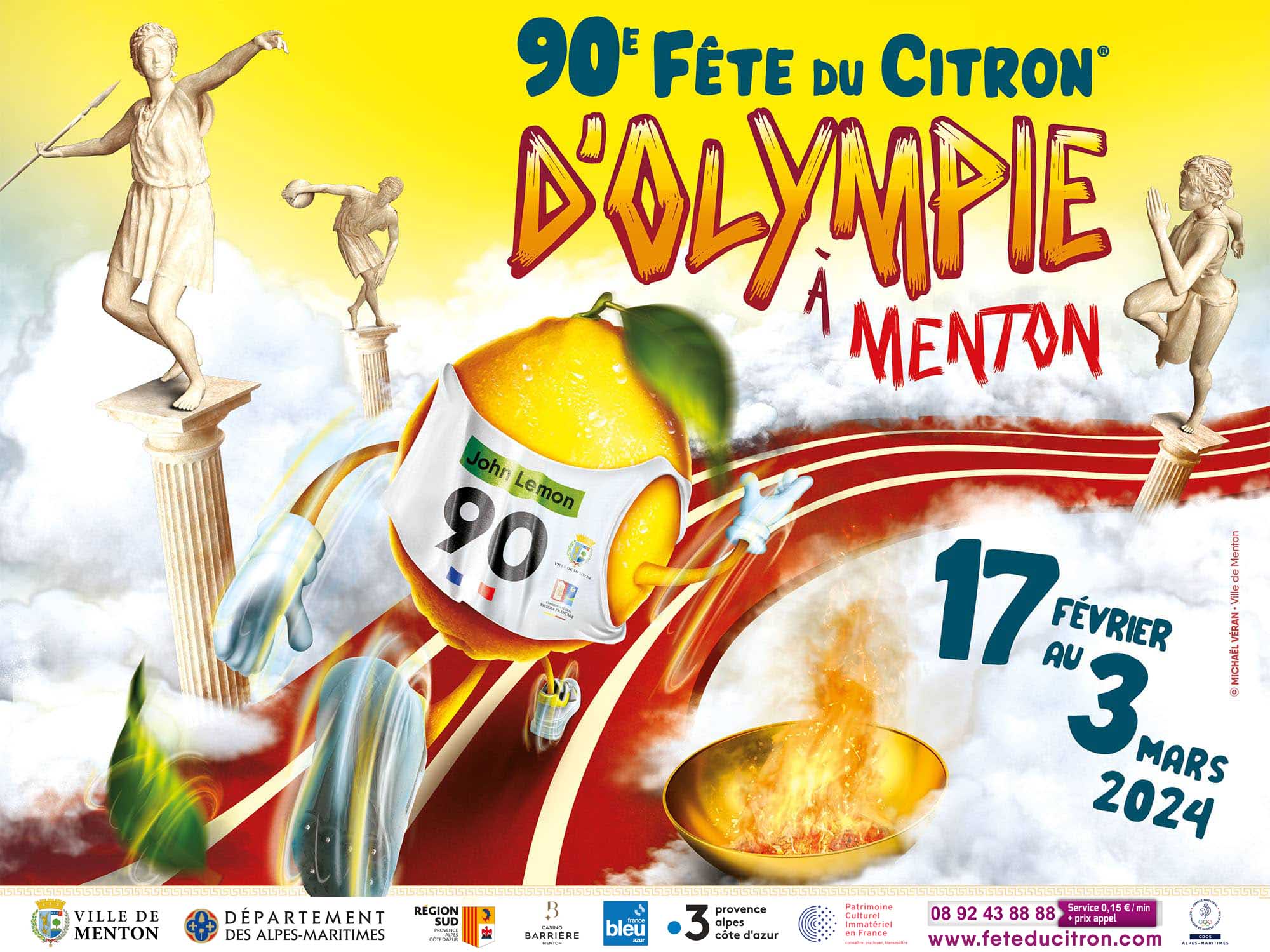
Ready for 2024? For the 89th edition of the Lemon Festival, John Lemon – the mascot of the town of Menton – is getting ready to go back on stage from the 17th of February to the 3rd of March. You’ll find his new appearance hilarious with a hairstyle inspired by Elvis Presley, a mouth and tongue from the Rolling Stones and a mask reminiscent of the American band Kiss!
The Lemon Festival of Menton, France
Every February, the little town of Menton on the French Riviera hosts one of France’s most popular events: the Lemon Festival (Fête du CitronⓇ).
![Lemon head in Menton © Paul Downey - licence [CC BY 2.0] from Wikimedia Commons](https://frenchmoments.eu/wp-content/uploads/2014/02/Lemon-head-in-Menton-01-©-Paul-Downey-licence-CC-BY-2.0-from-Wikimedia-Commons.jpg)
The Menton Tourist Board has organised the event towards the end of February since 1928. Today, each edition uses 140 tonnes of citrus fruit to decorate its gigantic structures and floats.
The festival has become the second largest Wintry event on the French Riviera, after the Carnival of Nice and before the Formula 1 Grand Prix of Monte Carlo. It takes place around the same time as the Carnival of Nice.
Each year, the festival features a theme: Disney, Music of the World, Spain, etc.
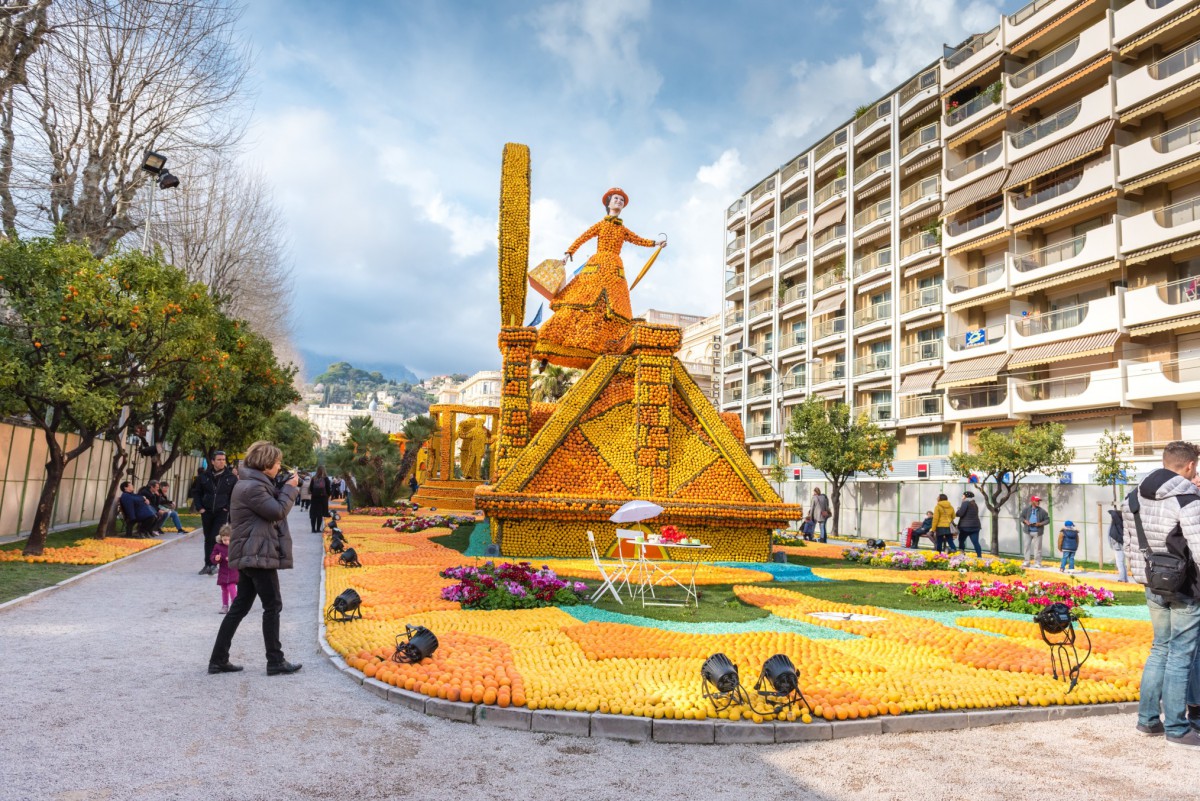
The Recent Lemon Festivals
- 2013 – the 80th edition of the Lemon Festival was “Around the world in 80 days: Menton, the secret port of call”.
- 2014 – the 81st edition of the festival was themed on a novel from Jules Verne: 20,000 Leagues under the Sea.
- 2015 – the 82nd edition was dedicated to ‘the tribulation of a lemon in China’.
- 2016 – the 83rd edition paid tribute to Cinecittà, the Italian cinema of the 50s and 60s.
- 2017 – the 84th edition was dedicated to Broadway and musical comedies.
- 2018 – the 85th edition was dedicated to Bollywood.
- 2019 – the 86th edition was “Des mondes fantastiques” (Fantastic Worlds).
- 2020 – the 87th edition was themed “Les Fêtes du Monde” (Festivals from around the World)
- 2021 – the cancellation of the festival due to the ongoing health crisis.
- 2022 – the 88th edition was back after a two-year gap with the theme “Opéras et Danses”
- 2023 – the 89th edition was themed “Rock & Opera”
- 2024 – the 90th edition pays tribute to the Paris Olympic Games with the theme: “D’Olympie à Menton”
Menton Lemon Festival: Facts and Figures
- 20 days-long Festival
- 240,000 spectators each year
- 1928: 1st exhibition of flowers and citrus fruit in the gardens of the Riviera Palace
- 1934: 1st edition in 1934 of the Fête du Citron
- 1st edition of the carnival-style event in 1935
- Each year has had its theme since 1955
- Over 750,000 elastic bands for attaching the citrus fruit
- 140 tonnes of citrus fruit for the gardens and floats
- 8 km of synthetic garlands
- 10 floats covered with citrus fruit parade the Promenade du Soleil
- 13 decorated displays in the gardens
And the festival has its mascot: John Lemon!
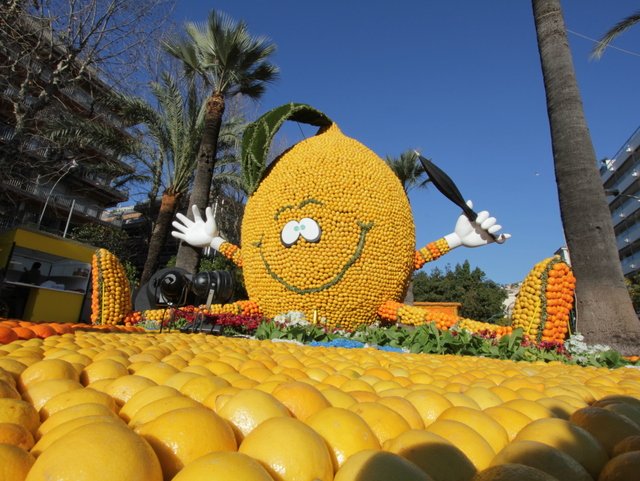
Warning! Things you should know for safety reasons!
You should know several things before entering the gardens or attending the parades.
You can’t bring with you:
- your dear pets (dog, cat, golden fish!)
- large suitcases or bags
- weapons, including artificial weapons
- crackers and fireworks
- glass and metal containers (bring plastic water bottles with you!)
- coil bomb
- roller skates, skateboard…
- blunt, sharp or pointed objects
- lastly, don’t come with disguises that may lead to confusion!!
This makes common sense, but it is always a good reminder!
The 4 not-to-miss events during the Menton Lemon Festival
During the Menton Lemon Festival, make sure you attend its four main events:
- The Exhibition of the Citrus Pattern (Exposition des Motifs d’Agrumes)
- The Gardens of Lights (Jardins de Lumières)
- The Golden Fruit Parade (Corso des Fruits d’Or)
- The Night-Time Parade (Corso Nocturne)
Here’s a snapshot of what to expect… with links to buy your tickets.
The exhibition of citrus patterns (Biovès Gardens)
The long and narrow Biovès Gardens next to the casino are walled off for the occasion. It features an impressive display of large wire-framed structures and sculptures built from thousands of citrus fruits (lemons, grapefruit and oranges). This dazzling display of sunshine colours requires nearly 15 tonnes of fruit and thousands of hours of creation and handling.
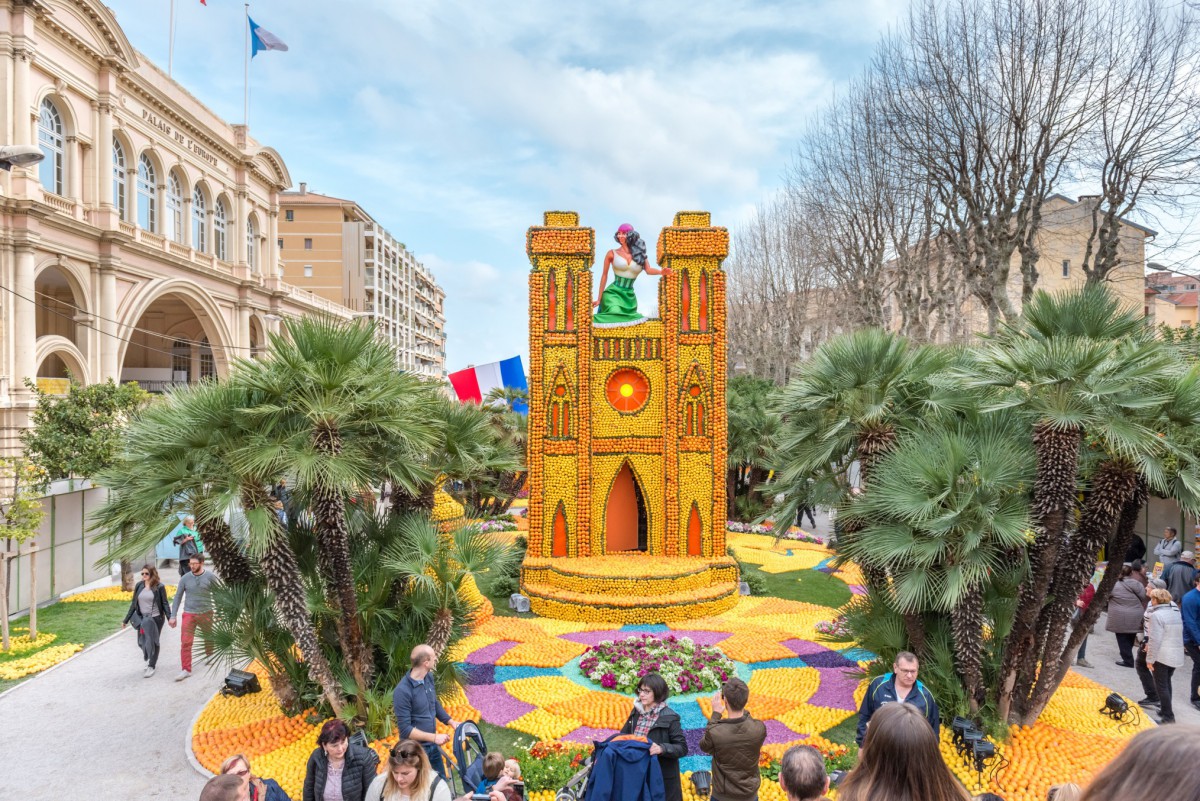
![Menton Lemon Festival © Bohyunlee - licence [CC BY-SA 4.0] from Wikimedia Commons](https://frenchmoments.eu/wp-content/uploads/2014/02/Menton-Lemon-Festival-02-©-Bohyunlee-licence-CC-BY-SA-4.0-from-Wikimedia-Commons.jpg)
![Menton Lemon Festival © Bohyunlee - licence [CC BY-SA 4.0] from Wikimedia Commons](https://frenchmoments.eu/wp-content/uploads/2014/02/Menton-Lemon-Festival-01-©-Bohyunlee-licence-CC-BY-SA-4.0-from-Wikimedia-Commons.jpg)

![Menton Lemon Festival 03 © Bohyunlee - licence [CC BY-SA 4.0] from Wikimedia Commons](https://frenchmoments.eu/wp-content/uploads/2014/02/Menton-Lemon-Festival-03-©-Bohyunlee-licence-CC-BY-SA-4.0-from-Wikimedia-Commons.jpg)
![Menton Lemon Festival 2013 © Perline - licence [CC BY-SA 3.0] from Wikimedia Commons](https://frenchmoments.eu/wp-content/uploads/2014/02/Menton-Lemon-Festival-2013-©-Perline-licence-CC-BY-SA-3.0-from-Wikimedia-Commons.jpg)

The gardens are open from the 17th of February to the 3rd of March 2024. Free admission. More info
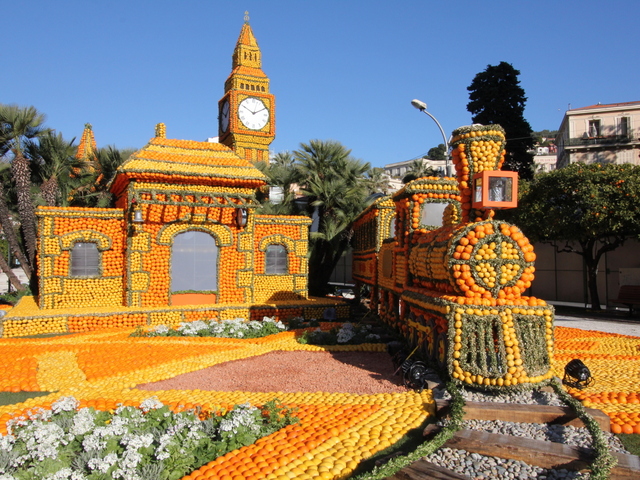

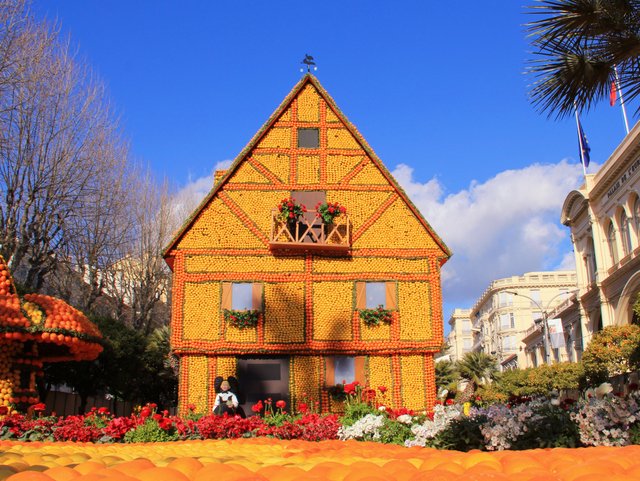
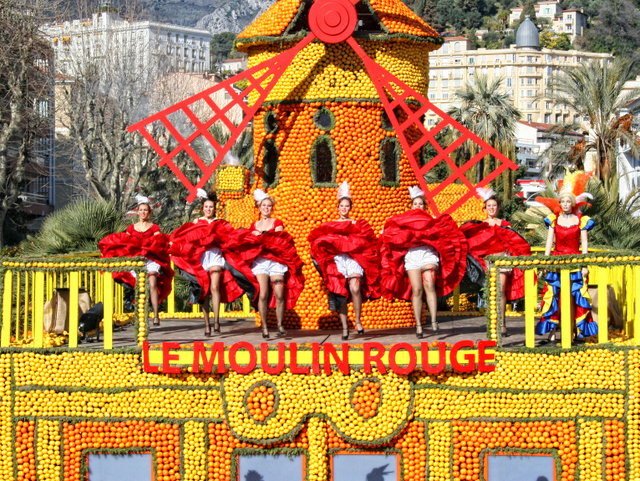
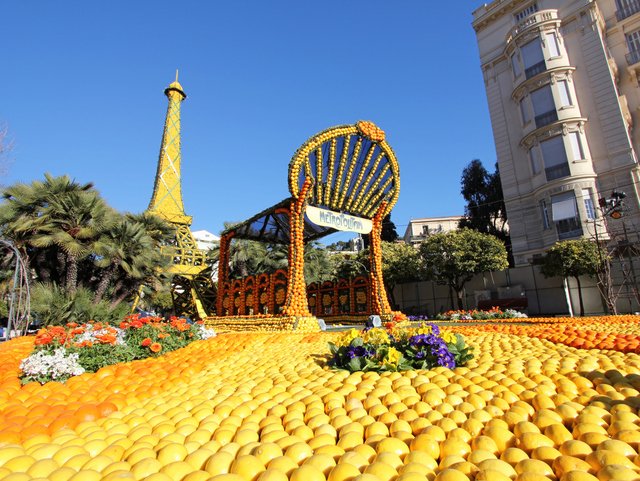

The Gardens of Lights
At night, the citrus structures at the Biovès Gardens are lit up to create a magical atmosphere with the addition of unusual sounds.
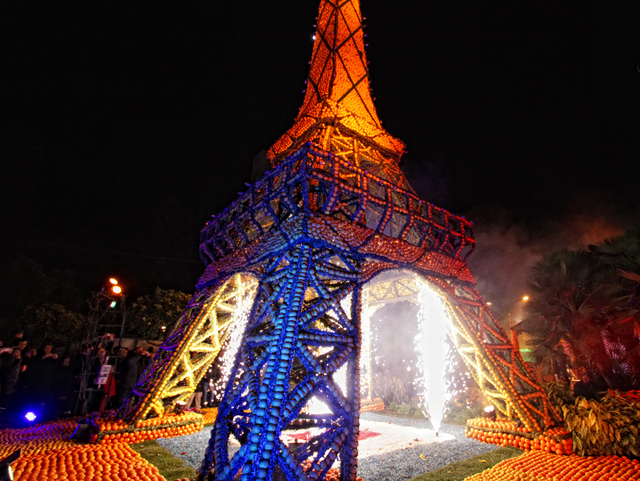
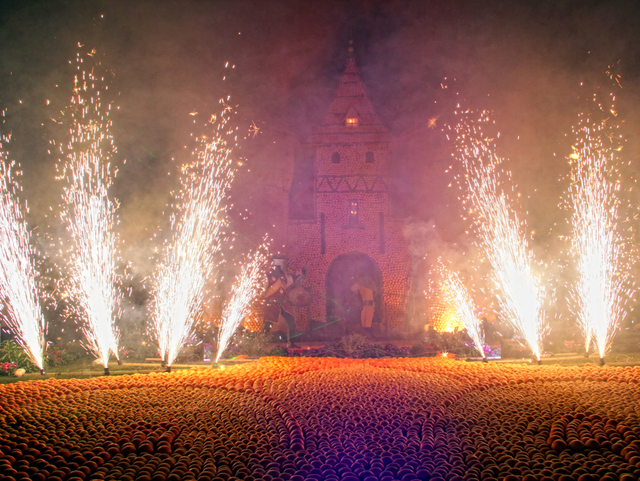



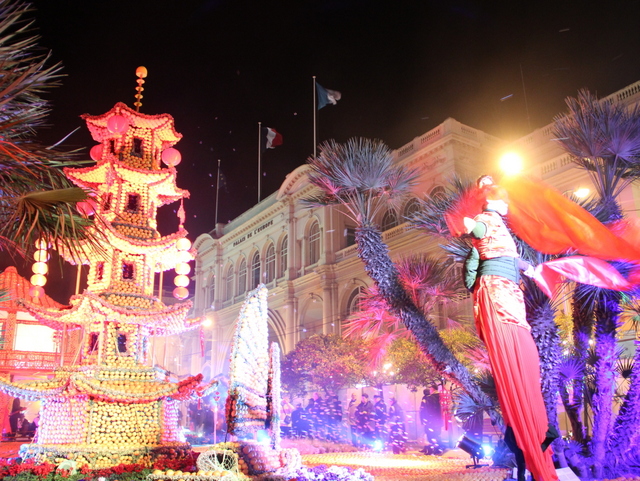
Free admission.
The Golden Fruit Parades
Each Sunday afternoon, colourful citrus fruit floats parade along the pebbly beachfront of Promenade du Soleil, accompanied by dancers, folk bands, fanfare and confetti.
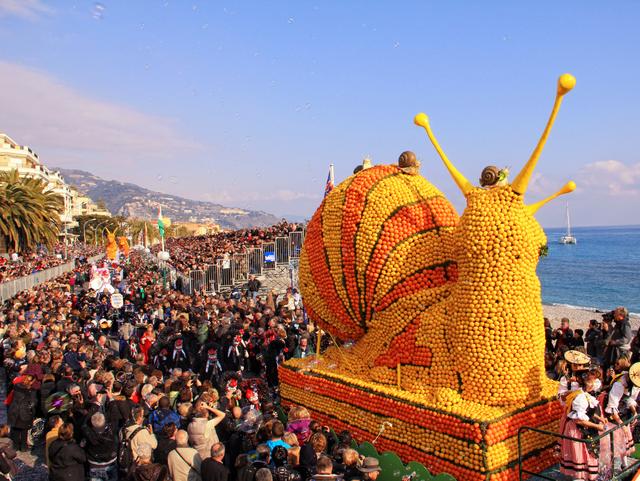
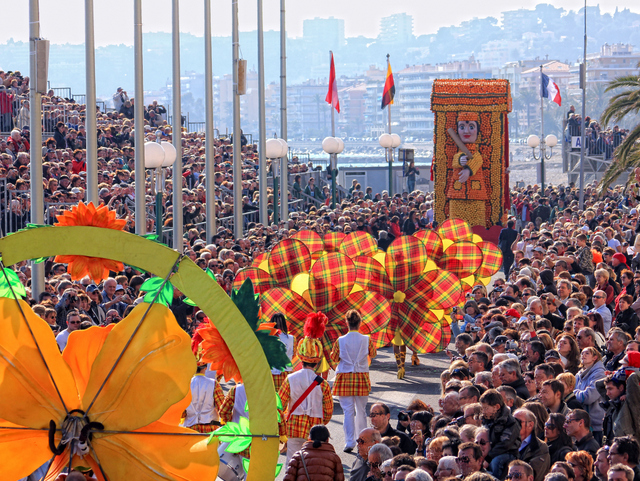
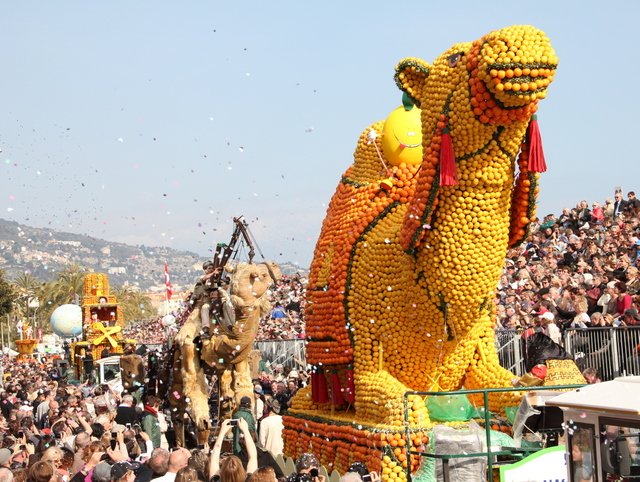
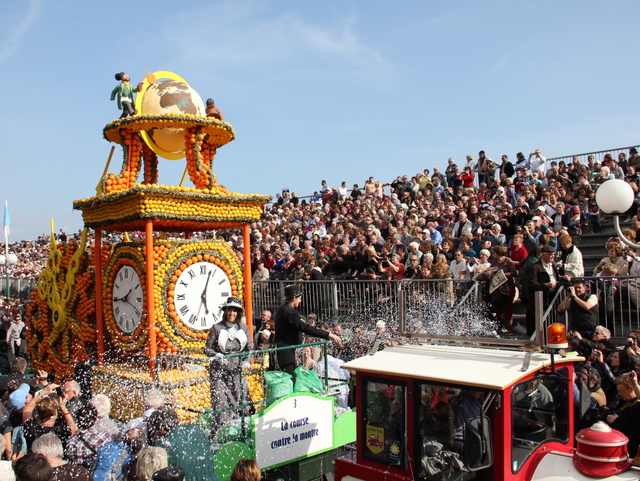
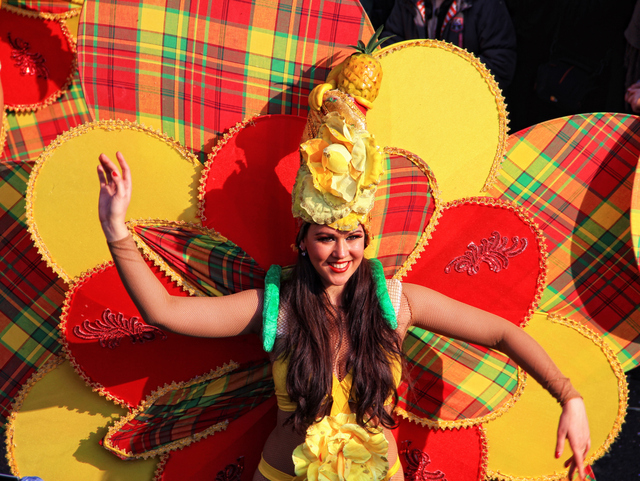
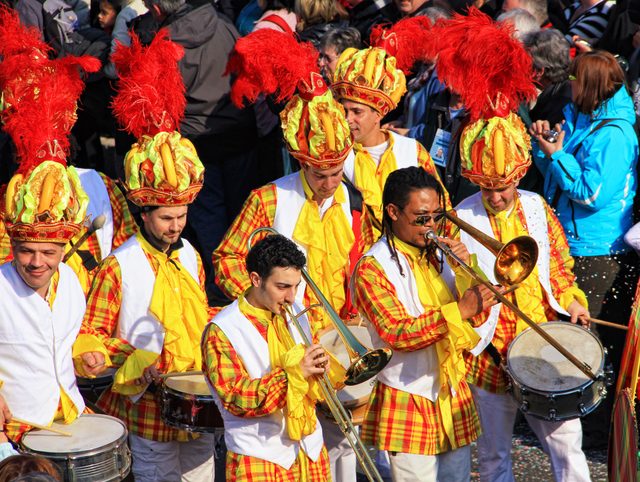
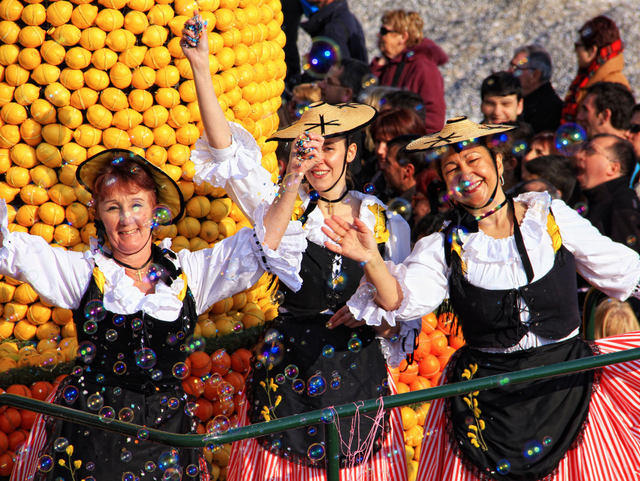
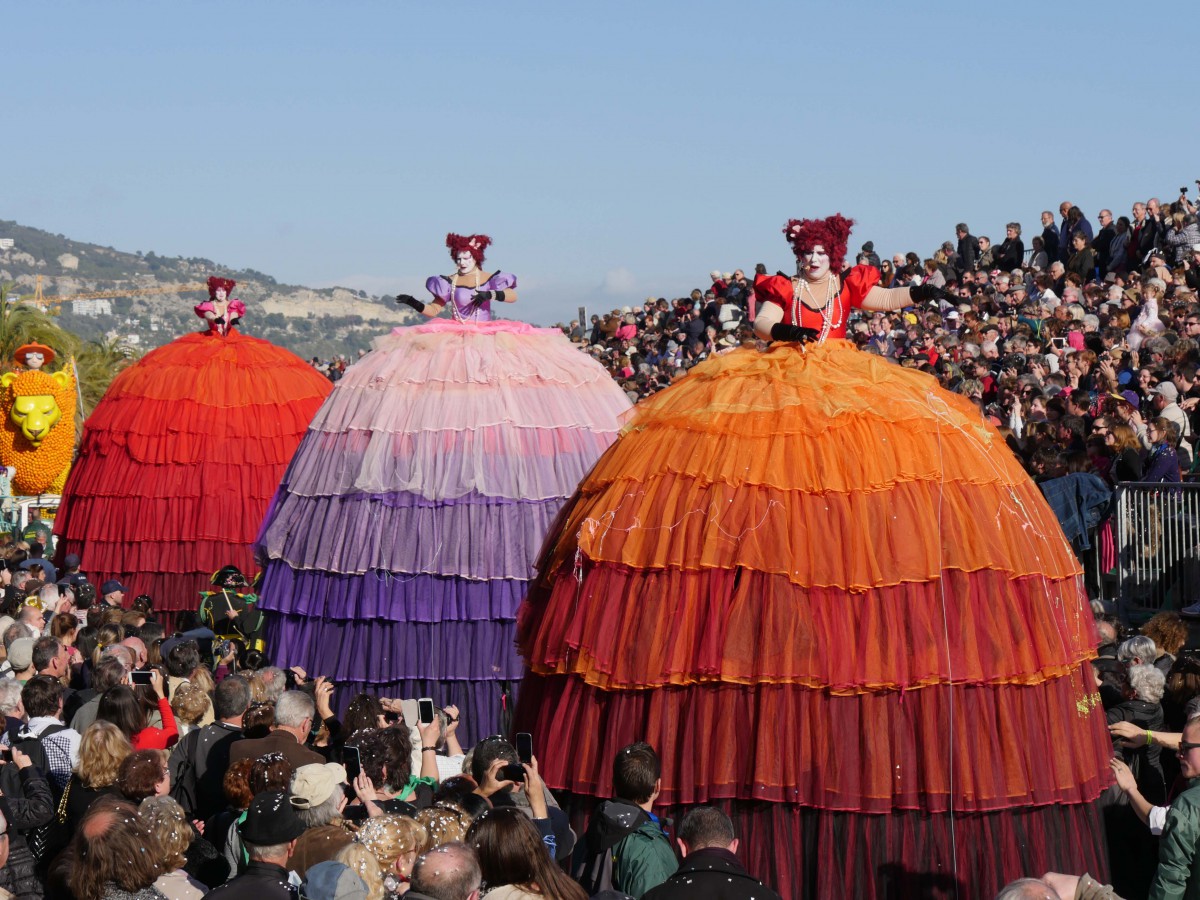
In 2024, the daytime parade occurs on Sundays, the 18th, 25th of February and 3rd of March, from 2.30 to 4 pm along the Promenade du Soleil. Buy your tickets here.
The night-time Parades
For two nights only, the Promenade du Soleil welcomes a colourful and exuberant parade.
The street festival features floats loaded with citrus fruit, brass bands, orchestras, folk groups, and dancers.
The night-time parade closes with a fireworks display at 10.30 pm.
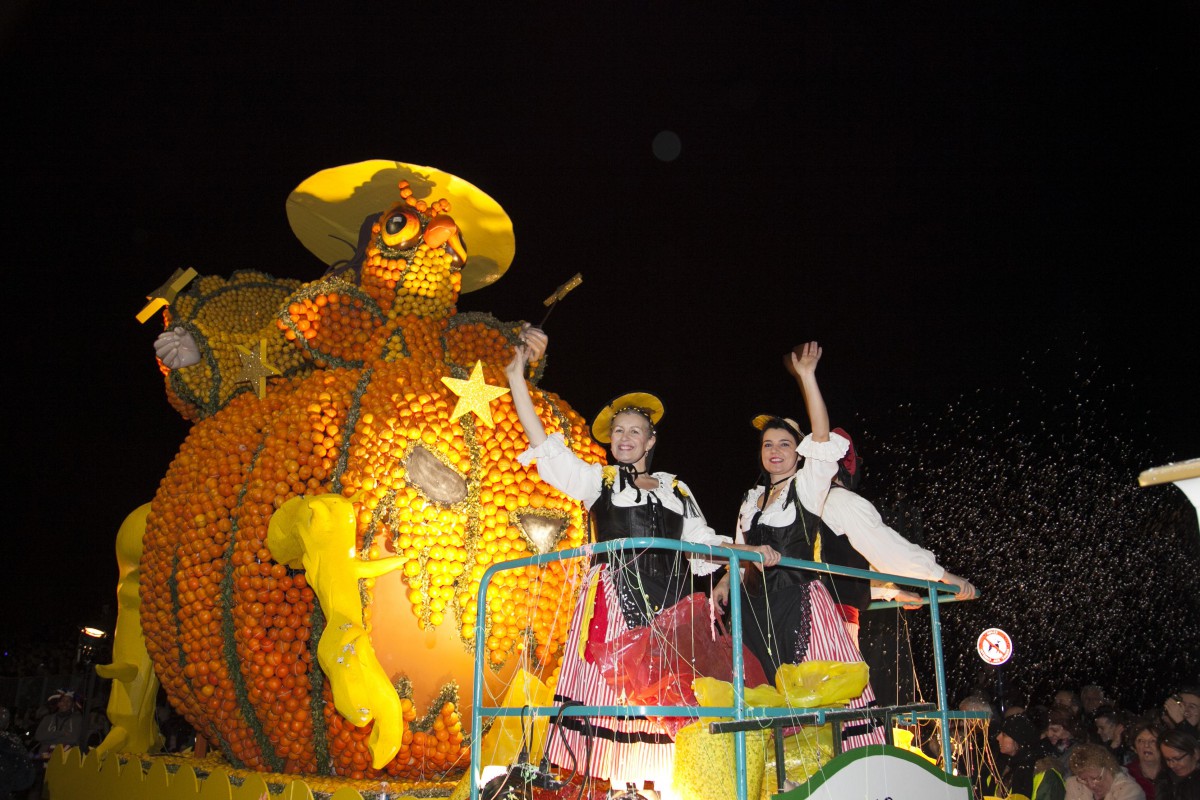
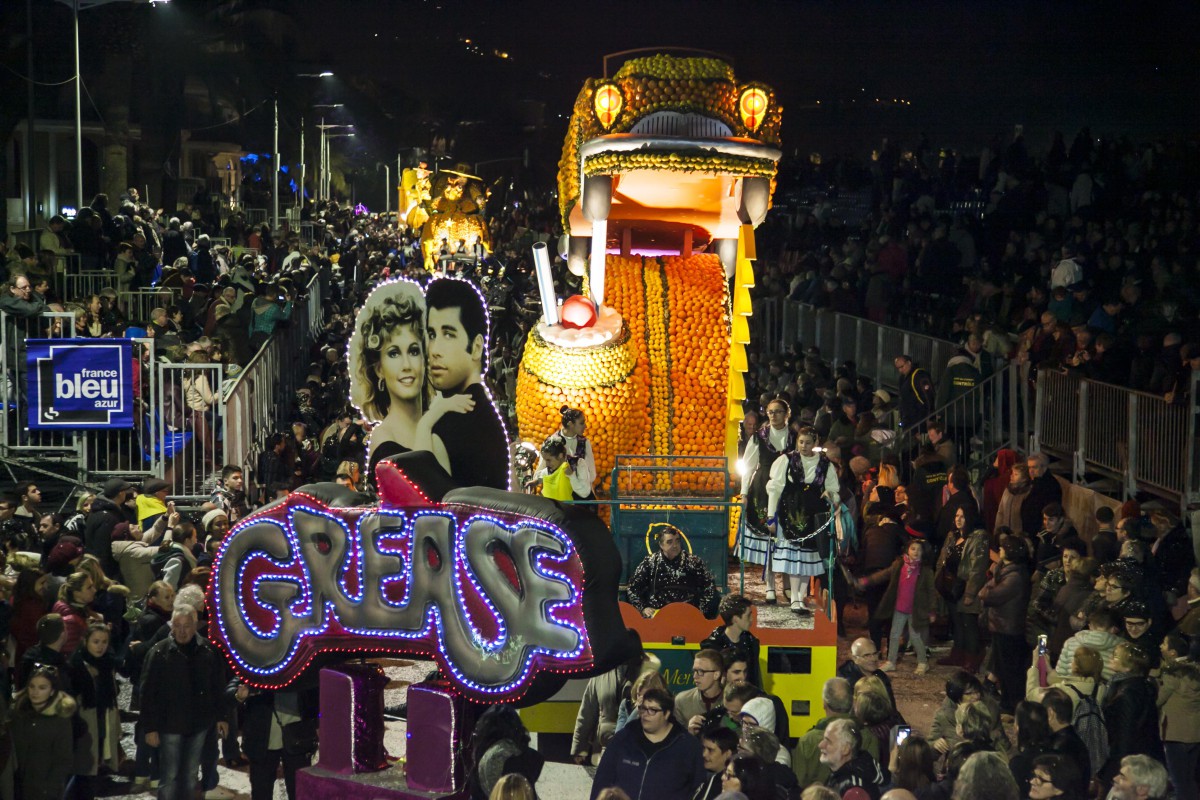
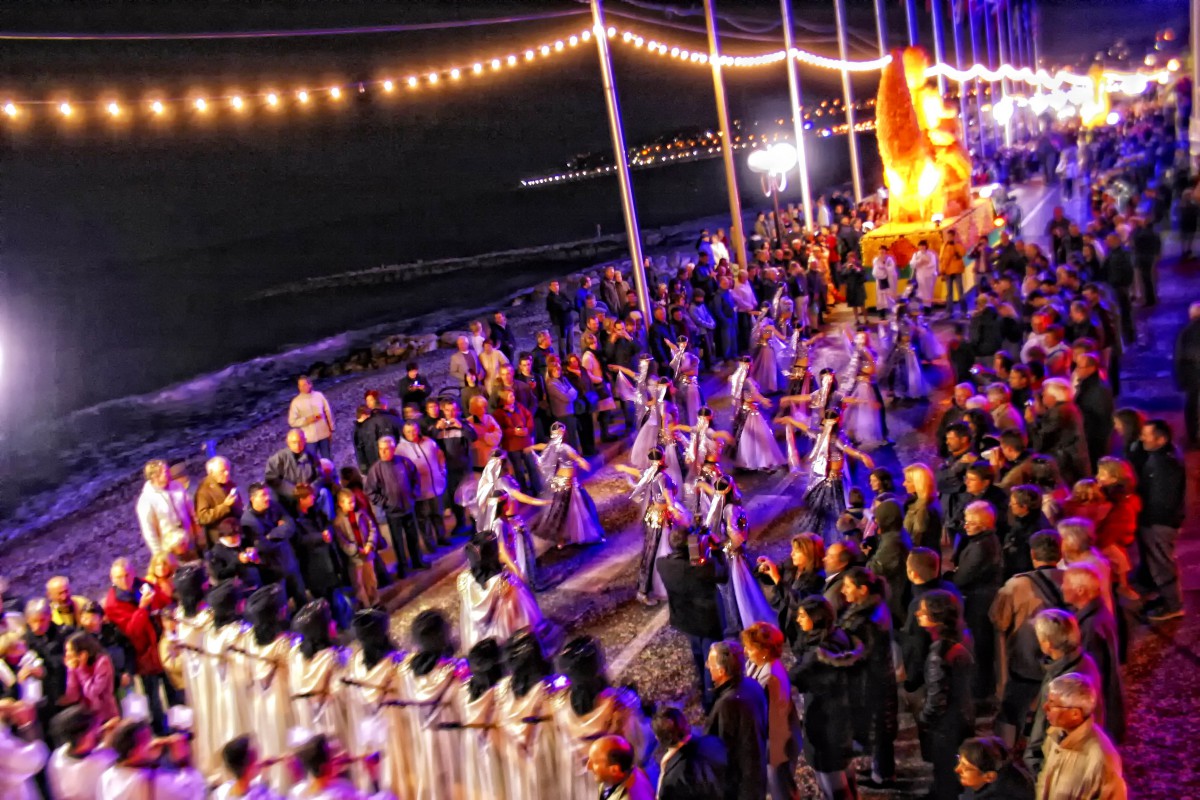


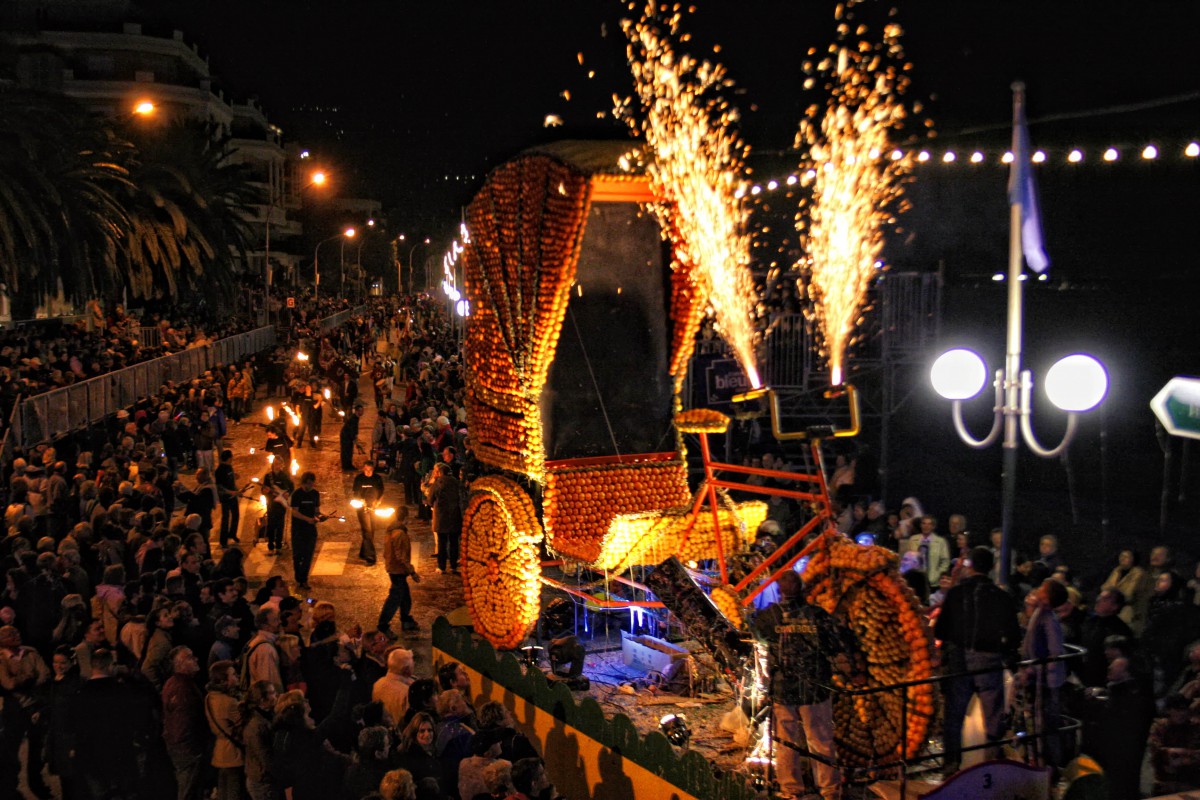
In 2024, the night-time parade will occur on Thursdays, the 22nd and 29th of February, at 9 pm along the Promenade du Soleil. Buy your tickets here.
The Menton Orchid Festival
Hosted by the esteemed Association des Orchidophiles et Epiphytophiles de France, the Menton Orchid Festival celebrates one of nature’s most enigmatic and elegant creations. In this event, orchids are not merely flowers but the stars of their vibrant garden.
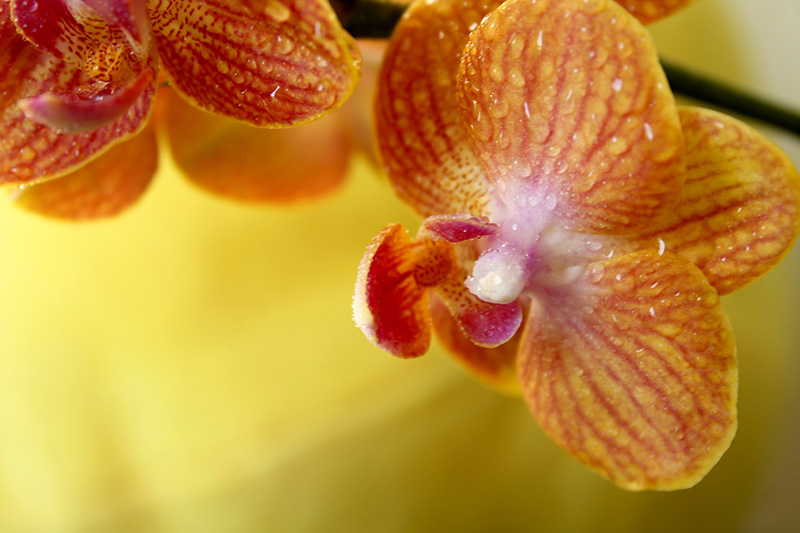
As you enter the festival, you are welcomed into a world where these exquisite blooms bask in the dappled light, showcasing an array of dazzling colours and intricate forms. Each orchid’s delicate and mysterious fragrance offers a visual feast, captivating visitors with unparalleled grace and beauty. These flowers don’t just catch your eye; they invite you into elegance and splendour.
The Orchid Festival is more than just an exhibition; it’s an escape into a serene oasis, a peaceful haven away from the whirlwind of everyday life. It’s a journey that promises to mesmerize and inspire, making it a perfect retreat for nature lovers, garden enthusiasts, and anyone seeking tranquillity.
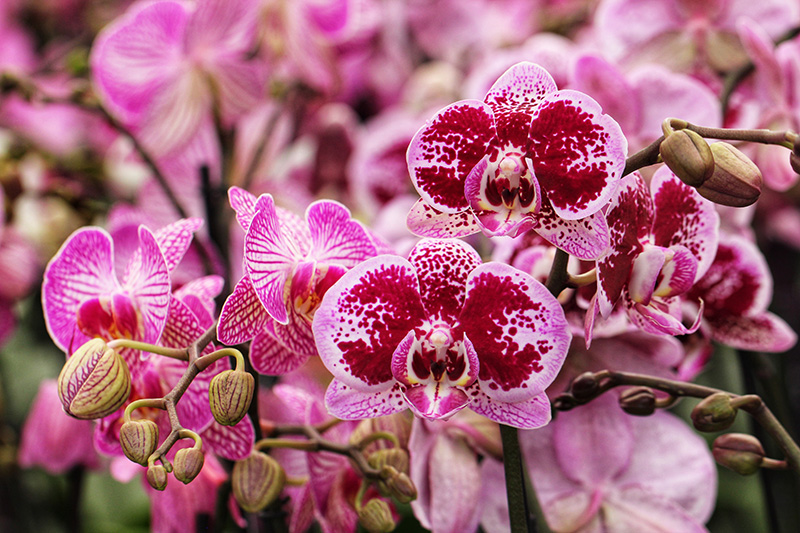
Festival Details
- Opening Hours: 10 am to 6 am daily.
- Special Note: On Saturday, the 17th of February 2024, the Palais de l’Europe opens at 2 pm.
- Admission: Free
- Festival Dates: from the 17th of February to the 3rd of March 2024
The lemon from Menton
![Menton, French Riviera © Vinbaron - licence [CC BY-SA 3.0] from Wikimedia Commons](https://frenchmoments.eu/wp-content/uploads/2014/08/Menton-©-Vinbaron-licence-CC-BY-SA-3.0-from-Wikimedia-Commons1.jpg)
The little town of Menton, France, is located 30 km east of Nice, where steep mountain cliffs and terraces slope dramatically to the Mediterranean Sea. The location of Menton is unique in France: the last coastal town before the Italian border is protected from the cold winds of the Alps by the surrounding mountains and, therefore, enjoys the warmest winter in the South of France (Corsica excepted) with more than 300 days of sunshine per year. This explains why this is the only place where lemons are grown in metropolitan France.
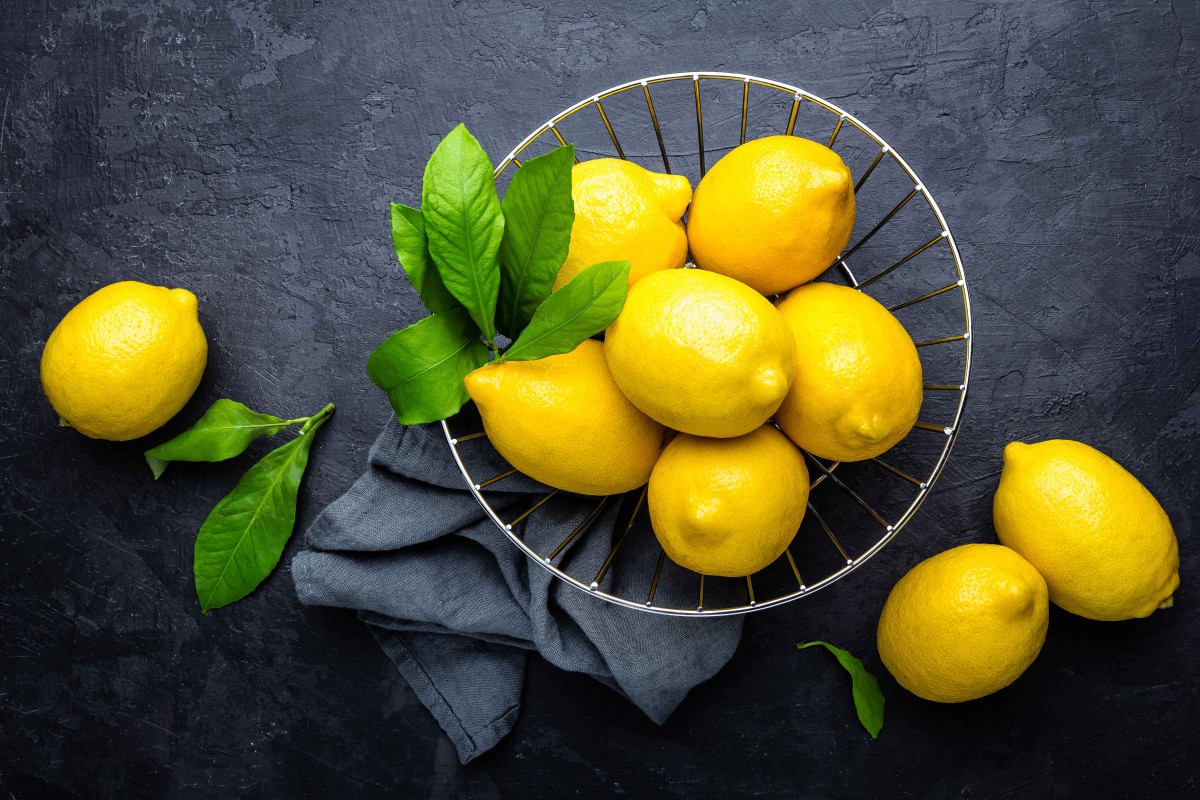
Until the 1930s, Menton and the Maritime Alps region were Europe’s largest lemon producers. The local production declined until recently when about 15 citrus growers preserved the tradition. Today, some 5,000 trees produce more than 150 tonnes of lemons yearly in Menton and the neighbouring communes of Roquebrune, Sainte-Agnès and Castellar.
Different lemon varieties
The lemon varieties that grow in Menton have names such as Santa Theresa, Villafranca, and Eureka. According to the Tourist Office, the shape of a Menton lemon is “more elliptical than round with a bright yellow colour. It is also characterised by great branches bearing up to fifteen fruits, while there are less than five to a branch on most lemon trees. The research with the INRA reveals that the lemons grown in the Menton region are rich in acid and essence, with high essential oil content in the peel”.
![Lemons from Menton © Perline - licence [CC BY-SA 3.0] from Wikimedia Commons](https://frenchmoments.eu/wp-content/uploads/2014/02/Lemons-from-Menton-©-Perline-licence-CC-BY-SA-3.0-from-Wikimedia-Commons.jpg)
Menton is therefore famous for its lemon tart (tarte au citron), and many shops in the old part of town sell lemon-related products: gingerbread, almond paste, boiled sweets, wine, vinegar, jam, soaps, candles and perfume…
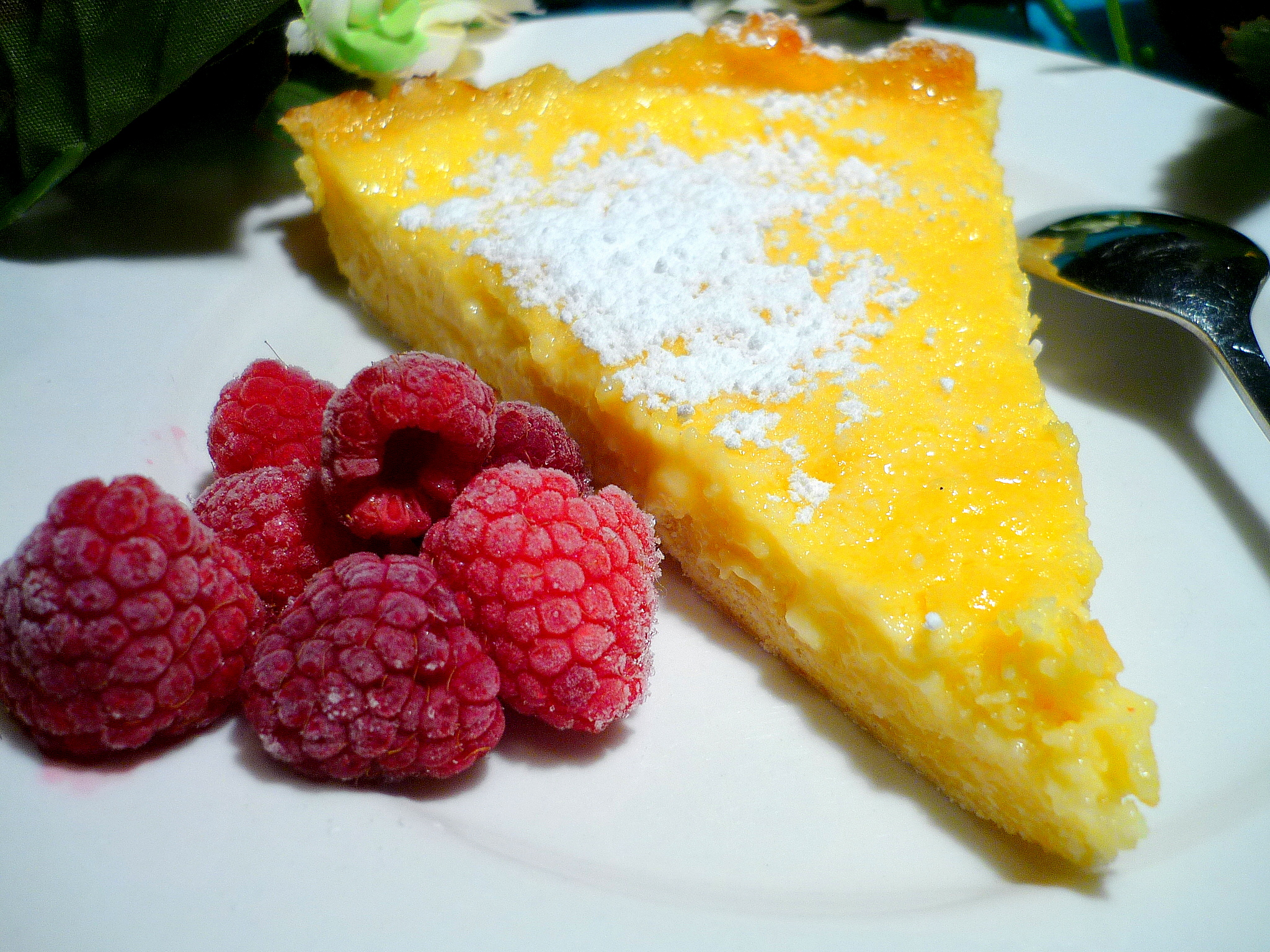
The Menton lemon is used by many great chefs who appreciate its flavour: Ducasse, Robuchon, and Bocuse.
Do all the lemons used during the festival come from Menton?
The lemons used in structures and floats during the festival have grown not in Menton but in Spain.
In fact, the production of Menton lemons is labelled IGP (Indication Géographique Protégée or Protected Geographical Indication). As the production is quite exclusive, it would be a shame to use such great produce in the carnival… in addition, there wouldn’t be enough lemons anyway to cater for the event!
What happens to the lemons after the festival?
After the end of the festival, the 140 tonnes of lemons, citrus fruits and flowers used in the structures and floats are sorted manually to be sold at a particular Sunday market for €1,50 / 3 kg (in 2018).
About Menton, the “Pearl of France”
Menton is nicknamed the “Pearl of France”. Located at the border with Italy and 30 km from Nice, the little town (pop. 30,000) is part of the Provence-Alpes-Côte d’Azur region.
![Menton French Riviera General View © MOSSOT - licence [CC BY-SA 3.0] from Wikimedia Commons](https://frenchmoments.eu/wp-content/uploads/2014/02/Menton-French-Riviera-General-View-©-MOSSOT-licence-CC-BY-SA-3.0-from-Wikimedia-Commons.jpg)
Find out more about Menton, France
- Discover Menton on the blog
- This is the link to the official website of the Menton Lemon Festival [in English]
- The Tourist Board of Menton-Riviera
- Where to stay for the Menton Lemon Festival? Click here for a selection of accommodation, or this map will help you find your accommodation in Menton according to location and prices:
How to get to the Menton Lemon Festival
Menton is a very accessible destination between Nice and Genova, Italy.
![TER at Menton Railway Station [public domain]](https://frenchmoments.eu/wp-content/uploads/2014/02/TER-at-Menton-Railway-Station-public-domain.jpg)
Take the car!
Menton is the last French town before the Italian border. It is accessible from Nice by the A8 motorway (exit number 59) or by following the Corniche Roads through Monaco (30km).
Land in Nice!
The closest airport is Nice-Côte d’Azur (42km), France’s second airport after Paris. Many international flights land here.
Catch the train!
Menton is easily accessible by train from Nice and Italy. The railway station in Menton is 200m from the Biovès Gardens. Trains take 30 minutes from Nice and 2h30 from Genova (Italy). TGV (high-speed trains) also connect Menton to Paris.
Menton Lemon Festival: English-French Vocabulary
![Menton Lemon Festival © Nicolas sartore - licence [CC BY-SA 4.0] from Wikimedia Commons](https://frenchmoments.eu/wp-content/uploads/2014/02/Menton-Lemon-Festival-01-©-Nicolas-sartore-licence-CC-BY-SA-4.0-from-Wikimedia-Commons.jpg)
- (f) for féminin, (m) for masculin, (adj) for adjective and (v) for verbs
- carnival = carnaval (m)
- citrus fruit = agrume (m)
- Festival = festival (m), fête (f)
- fireworks = feu d’artifice (m)
- float = char (m)
- French Riviera = Côte d’Azur (f)
- garden = jardin (m)
- Italy = Italie (f)
- lemon = citron (m)
- lemon tart = tarte au citron (f)
- Mediterranean Sea = Mer Méditerranée (f)
- parade = défilé (m)
- town = ville (f)




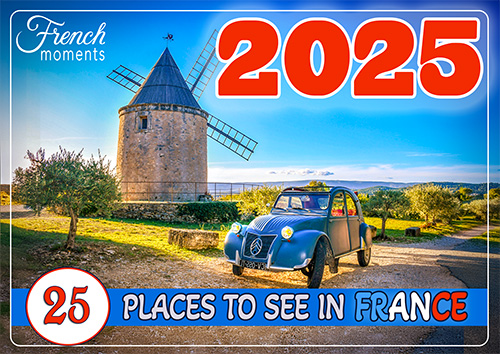
What happens o the fruit after the festival is over? Does it go into a landfill?
Excellent question, thank you for asking! I updated the article with the answer:
“After the end of the festival the 140 tonnes of lemons, citrus fruits and flowers used in the structures and floats are sorted manually to be sold at a special Sunday market for the price of €1,50 / 3 kg (in 2018).” 🙂